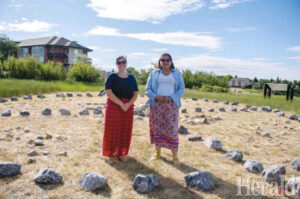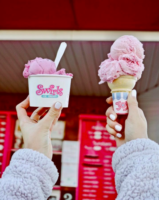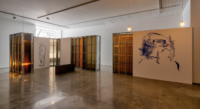Sunrise ceremony unites cultures
By Yoos, Cam on June 22, 2020.
 Herald photo by Greg Bobinec -
Sabrina Ross and Rachel Hoof from Family Ties Association stand in the Medicine Wheel outside of the Galt Museum where they hosted a National Aboriginal Day Sunrise Ceremony Sunday morning.
Herald photo by Greg Bobinec -
Sabrina Ross and Rachel Hoof from Family Ties Association stand in the Medicine Wheel outside of the Galt Museum where they hosted a National Aboriginal Day Sunrise Ceremony Sunday morning.Greg Bobinec
Lethbridge Herald
As a way to still celebrate the diversity and history of southern Alberta, members of the Family Ties Association of Lethbridge hosted a Sunrise Ceremony to celebrate and recognize National Indigenous Peoples Day, with a Sunrise Ceremony behind the Galt Museum.
After attending a ceremony in Calgary, Family Ties Associations Clinician and Blackfoot Knowledge Holder, Rachel Hoof, thought it would be a good initiative to bring it to Lethbridge to connect the different cultures together without resentment, as well as honour and celebrate Indigenous traditions.
“I thought it would be a good way to provide some hope at the end of this COVID pandemic,” says Hoof.
“I wanted to bring our group together in a way that is acknowledging and respectful of the Blackfoot culture, the territory that we are on because we don’t provide those opportunities for both cultures to come together and heal, and not doing it in a shame or blame way because that has never helped and it keeps us divided.”
The ceremony took place on the Medicine Wheel placed in the tall grasses behind the Galt Museum. With the historical significance of Indian Battle Park and the Medicine Wheel, all placed on Blackfoot Territory, Hoof thought it was the perfect spot for the ceremony.
“Being here at the river bottom, trying to do some healing around the land and the historical events that have happened here, in terms of the whiskey traders, and then on top of that, there was a huge battle between the Cree and the Blackfoot,” says Hoof.
“Coming to this Medicine Wheel, this rock circle or sun dial, whoever set it here did it with good intentions and I thought that we should make use of it, and one of the participants actually said they didn’t know it was here because it was covered by grass, but I thought it would be neat to hold it here.”
Dozens of participants from Family Ties and other community members joined together in the early hours Sunday to witness and participate in the prayer and smudging, as well as to gain knowledge on how Indigenous people originally lived before colonization.
“The sun when it comes up early in the morning, that is the most spiritual time of the day, and it also goes back to our collective tribal ways,” says Hoof. “If you didn’t get up early and do your fair share of the work, you were shunned, so we get up early because we know when the sun is coming up at 4 a.m., you start your prayers to the Creator and that is when their most powerful time comes through.”
Although the Sunrise Ceremony was to signify National Aboriginal Day, organizers also used it as an opportunity to come together and bless each other for the summer, where rejuvenation and reconnection is welcomed.
“Summer Solstice, going into the summer, it is a good time, berries are ripening and the animals are in full flux, so it is just a good time,” says Hoof. “Blessing and prayers to make sure you make it through the summer, you reconnect and rejuvenate, renew those relationships with your family members that you haven’t been able to see through the winter.”
The unifying Sunrise Ceremony brought people out from all walks of life and cultures to celebrate and learn more about Indigenous culture throughout the area, their traditions, and to commemorate National Aboriginal Day.
Follow @GBobinecHerald on Twitter
17-16




